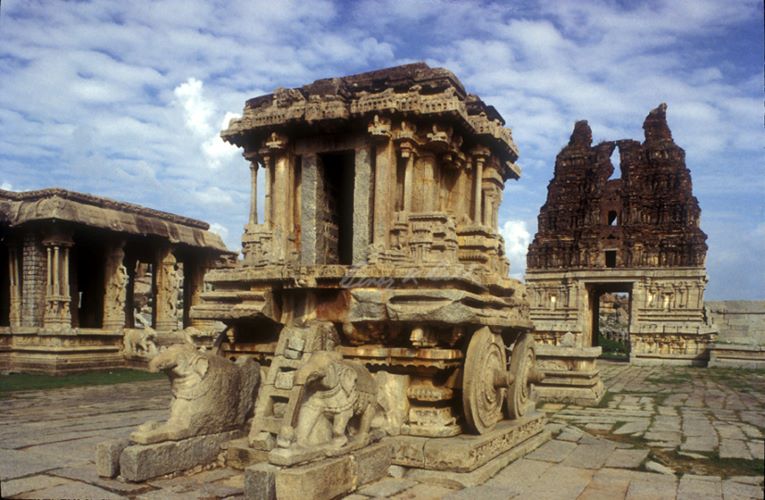Witness the imperial city of Vijayanagara at India Habitat Centre this weekend

Hampi. Photo credit: Benoy K Behl
Team L&M
The film Imperial City of Vijayanagara is part of the series of documentaries ‘Spectacular India’, produced by Art Historian, Filmmaker and Photographer Benoy K Behl for Doordarshan. India Habitat Centre, New Delhi is showing this film and holding a talk on it under its Glimpses of Culture series on September 24, at 6pm. Behl tells us more about the city of Vijayanagara:
The Vijayanagara Empire emerged in the mid-14th century and soon encompassed most of South India, from coast to coast. By the mid-15th century, the kingdom stretched from North Karnataka to Kerala and from the Malabar Coast to Orissa.
At Hampi, on the banks of the Tungabhadra river, was made the imperial capital Vijayanagara or The City of Victory. It was one of the greatest metropolises of India, in fact of the entire medieval world. Foreign travelers who came to the city could scarcely believe what their eyes saw.
Today, the ruins of Hampi are cover 30 square kilometers and over 500 monuments have been identified. One can imagine what a glorious sight met Abdur Razzak an ambassador of Persia, when he visited Vijayanagara during the reign of Deva Raya II at the end of 1442. He said, “The City of Vijayanagara is such that the pupil of the eye has never seen a place like it, and the ear of intelligence has never been informed that there existed anything equal to it in the world.”
A vibrant culture was created in Vijayanagara. From the 14th to the 16th centuries, Hampi was one of the most prosperous cities in the world. People of different countries rubbed shoulders with each other in market places here. Portuguese merchants brought the best horses from Arabia, diamonds came here from Golconda and textiles and spices flowed here from all corners. This was one of the most thriving and cosmopolitan places in the world.
In the words of Domingo Paes a Portuguese visitor in Vijayanagara between 1520-22, “The size of this city I do not wish to write here, because it cannot all be seen from any one spot, but I climbed on a hill whence I could see a great part of it…What I saw from thence seemed to me as large as Rome and very beautiful to the sight…”
“The people in this city are countless in number, so much so that I do not wish to write it down for fear it should be thought fabulous…This is the best provided city in the world…” Domingo Paes
“In this city you will find men belonging to every nation and people, because of the great trade which it has and the many precious stones there, principally diamonds.” Domingo Paes
“…You will find all sorts of rubies, and diamonds and emeralds and pearls and seed pearls and cloths and every other sort of thing there is on earth and that you may wish to buy. Then you have there every evening a fair where they sell many common horses…” Domingo Paes
Abdur Razzak said about the market places, “Roses are sold everywhere. These people could not live without roses, and they look upon them as quite as necessary as food…Each class of men belonging to each profession has shops contiguous the one to the other; jewelers sell publicly in the bazaars pearls, rubies, emeralds, and diamonds.”

Duarte Barbosa, also from Portugal wrote of Hampi in 1518, “The streets and squares are very wide. They are constantly filled with an innumerable crowd of all nations and creeds…there is an infinite trade in this city…in this city there are many jewels which are brought from Pegu and Ceylon, and in the country itself many diamonds are found…There are also many pearls and seed pearls to be found there, which are brought from Ormuz and Cael…also silk-brocades, scarlet cloth and coral…”
The Portuguese visitor was very impressed by the ceremonial wooden rathas which he saw near the great temples of Hampi. “Close to the pagodas is a triumphal car covered with carved work and images, and on one day in each year during a festival they drag this through the city in such streets as it can traverse. It is large and cannot turn corners.” Domingo Paes
The Vijayanagara Empire depended for its great military might upon its cavalry. Horses remained exceedingly important to the kings of Vijayanagara. The Portuguese who captured Goa in 1510 became the principal suppliers of Arabian horses to the kings of Vijayanagara.
Varthema an Italian traveler, who visited Hampi in 1506, writes, “The king keeps up constantly 40,000 horsemen and 400 elephants. …(The king’s horse) is worth more than some of our cities on account of the ornaments which it wears.”
The joyous and exuberant life of the prosperous city of Hampi comes alive in the exquisite friezes of the Mahanavami Dibba. Here we see a lively dancer and musician.
The rich cosmopolitan culture of Hampi is reflected in the many low-relief friezes, which present a detailed and unique record of the life of the great city.
The fabulous wealth and prosperity of the Vijayanagara empire is captured in Domingo Paes’ description of noble women whom he saw, dressed up for a festive occasion: “Who is he could tell of the costliness and the value of what each of these women carries on her person? So great is the weight of the bracelets and gold and jewels carried by them that many of them cannot support them and women accompany them, assisting them by supporting their arms.”


